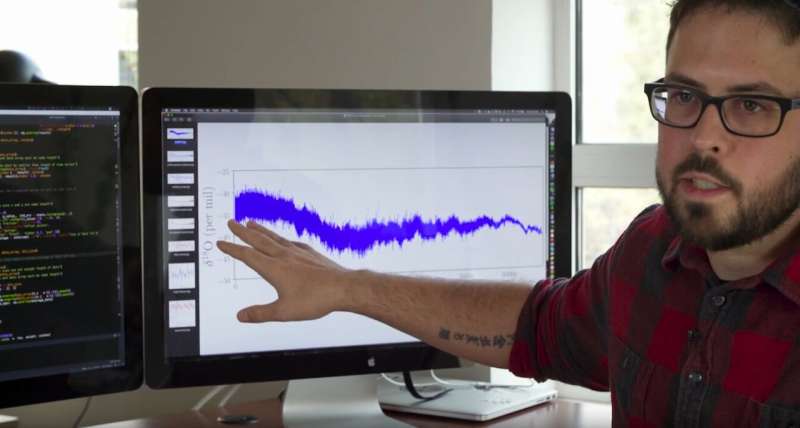Information theory as a forensics tool for investigating climate mysteries

During Earth's last glacial period, temperatures on the planet periodically spiked dramatically and rapidly. Data in layers of ice of Greenland and Antarctica show that these warming events—called Dansgaard-Oeschger and Antarctic Isotope Maximum events—occurred at least 25 times. Each time, in a matter of decades, temperatures climbed 5-10 degrees Celsius, then cooled again, gradually. While there remain several competing theories for the still-unexplained mechanisms behind these spikes, a new paper in the journal Chaos suggests that mathematics from information theory could offer a powerful tool for analyzing and understanding them.
"In many systems, before an extreme event, information dynamics become disordered," says Joshua Garland, a postdoctoral fellow at the Santa Fe Institute and lead author on the new paper. For instance, information theoretic tools have been used to anticipate seizure events from disturbances in EEG readings.
Initially, the authors anticipated they would see a signal—a destabilization in the climate record similar to those seen in pre-seizure EEGs—just before the warming events. But those signals never appeared. "Around these events, you have the same amount of information production," says Garland. And this, suggest the authors, indicates that Dansgaard-Oeschger and Antarctic Isotope Maximum events were most likely regular and predictable patterns of the climate of the last glacial period rather than the results of unexpected events.
In addition, information theory could improve how scientists calculate accumulation—how much snow fell in any given year. "It's very challenging. Many people are working on this, and they are using sophisticated math, combined with expert knowledge and known features, to figure out the accumulation," says Garland. Currently, fine pollen signatures are some of the best differentiators between years in ice that is tens of thousands of years old, compressed under the weight of each subsequent snowfall. Information theory, and specifically a statistical approach called permutation entropy, offers a different approach. "This could be a fast and efficient tool for the experts to corroborate their work," says Garland.
"When you're dealing with a timeseries, you want to know what meaningful information is present. You want to extract it and use it, and to not use information that isn't useful," says Garland. "We hope this tool can help scientists do this with ancient climate records."
Information theory is already being used to identify anomalies in the climate record—particularly, to flag anomalies introduced during the collection and observation of the ice cores.
This paper follows on the heels of two related studies published in Entropy and Advances in Intelligent Data Analysis XV.
"These information-theoretic calculations are not only useful for revealing hidden problems with the data, but also potentially powerful in suggesting new and sometimes surprising geoscience," write the authors in the new paper.
More information: Joshua Garland et al, An information-theoretic approach to extracting climate signals from deep polar ice cores, Chaos: An Interdisciplinary Journal of Nonlinear Science (2019). DOI: 10.1063/1.5127211
Journal information: Chaos
Provided by Santa Fe Institute




















